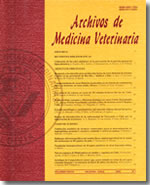Vitrificación de ovocitos bovinos y su uso en el desarrollo partenogenético de embriones
Contenido principal del artículo
Resumen
El objetivo de este trabajo fue evaluar el efecto de la vitrificación en la viabilidad de ovocitos activados químicamente para la producción de embriones partenogenéticos bovinos. Ovocitos bovinos aspirados de ovarios obtenidos en el matadero fueron madurados in vitro por 20-22 horas y se distribuyeron en los siguientes grupos. I (n=76): ovocitos vitrificados/descongelados, II (n=119): ovocitos expuestos a crioprotectantes sin vitrificación y III (n=142): ovocitos control. Los ovocitos fueron vitrificados en microgotas sobre un papel de aluminio preenfriado flotando en nitrógeno líquido, utilizando una solución de equilibrio con 4% de etilenglicol y una solución de vitrificación con 35% de etilenglicol 5% de polivinilpirrolidona y 0,4 M de trehalosa. Las microgotas vitrificadas fueron almacenadas en nitrógeno líquido y fueron descongeladas 1-3 días después del almacenamiento. Los tres grupos de ovocitos se activaron partenogenéticamente por exposición de 4 minutos a 5 µM de ionomicina de Ca a temperatura ambiente seguido de una incubación por 5 horas en 6-dimetilaminopurina a 38,5 ºC en una atmósfera húmeda con 5% CO2. Los embriones se cultivaron en medio mSOF durante 8-9 días. Las tasas de ovocitos sobrevivientes fueron 55,1% y 93,7% para ovocitos vitrificados/descongelados (I) y expuestos (II) respectivamente. Las tasas de segmentación de 55,3%, 72,3% y 74,6%, y de desarrollo hasta blastocistos fueron 7,1%, 17,4% y 21,7% en los grupos I, II y III respectivamente. Estos resultados demuestran que la técnica de vitrificación ha quedado establecida y permite la producción de embriones partenogenéticos bovinos.

